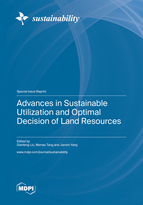Advances in Sustainable Utilization and Optimal Decision of Land Resources
A special issue of Sustainability (ISSN 2071-1050). This special issue belongs to the section "Sustainable Urban and Rural Development".
Deadline for manuscript submissions: closed (30 November 2022) | Viewed by 18994
Special Issue Editors
Interests: sustainable utilization of land resources and ecological effect; spatial planning; geospatial modeling and applications using geographic information systems
Special Issues, Collections and Topics in MDPI journals
Interests: GIS and spatial analysis and modeling; agent-based models and spatiotemporal simulation; cyberinfrastructure and high-performance computing; complex adaptive spatial systems; land use and land cover change
Special Issues, Collections and Topics in MDPI journals
Interests: spatial analysis; environment; environmental impact assessment; land use planning; natural resource management; mapping; spatial statistics; sustainability; geoinformation; geographical analysis
Special Issues, Collections and Topics in MDPI journals
Special Issue Information
Dear Colleagues,
Land resources are essential for human beings to survive. With rapid socioeconomic development and increasing urbanization, land resources have borne increasing pressure from multiple stakeholders, which accelerates land use competition and conflicts. In this context, the sustainable utilization of land resources has been regarded as one of the key indicators in the 2030 agenda for worldwide Sustainable Development Goals (SDGs), and has attracted a great deal of attention from countries around the world. The optimal utilization of land resources needs to take into account multiple aspects of land systems and interactions with other physical and socioeconomic systems (e.g., ecosystem, climatic system, and human activities). Although extensive studies have focused on the optimal allocation of land resources from theoretical and methodological aspects, few have highlighted the coupled relationships of humans and nature as well as the interactions of various related systems in the process of land use decision making. This Special Issue aims to present recent advances in the Sustainable Utilization and Optimal Decision of Land Resources. We seek papers that explore new theoretical, methodological, and experimental subjects regarding the optimal utilization of land resources. Policy-oriented papers are also welcomed to present various decision-making processes of land resources from a wide range of backgrounds.
Potential topics include, but are not limited to, the following:
- Land use and climate change adaptation;
- Land use change and its ecological effects;
- Spatial optimization for land use allocation;
- Simulation methods of land use change;
- Intelligent algorithms in land use decision-making;
- Sustainable evaluation of land use;
- Delineation of ecological redlines and urban growth boundaries;
- Spatial planning principles and practice.
Dr. Dianfeng Liu
Dr. Wenwu Tang
Dr. Jianxin Yang
Guest Editors
Manuscript Submission Information
Manuscripts should be submitted online at www.mdpi.com by registering and logging in to this website. Once you are registered, click here to go to the submission form. Manuscripts can be submitted until the deadline. All submissions that pass pre-check are peer-reviewed. Accepted papers will be published continuously in the journal (as soon as accepted) and will be listed together on the special issue website. Research articles, review articles as well as short communications are invited. For planned papers, a title and short abstract (about 100 words) can be sent to the Editorial Office for announcement on this website.
Submitted manuscripts should not have been published previously, nor be under consideration for publication elsewhere (except conference proceedings papers). All manuscripts are thoroughly refereed through a single-blind peer-review process. A guide for authors and other relevant information for submission of manuscripts is available on the Instructions for Authors page. Sustainability is an international peer-reviewed open access semimonthly journal published by MDPI.
Please visit the Instructions for Authors page before submitting a manuscript. The Article Processing Charge (APC) for publication in this open access journal is 2400 CHF (Swiss Francs). Submitted papers should be well formatted and use good English. Authors may use MDPI's English editing service prior to publication or during author revisions.
Keywords
- land resources
- sustainability
- decision-making
- land use change
- spatial optimization
- spatial planning
- land use allocation







